|

Pete Bongo clip AUDIO
 VIDEO
VIDEO

Other than those percussionists wanting
to specialise in hand drums, if any of you drummers out there are
considering adding hand percussion to your set up then I’d strongly
recommend bongos. They’re easily affordable, very portable and have a
lot of possible applications be it with sticks or hands.
If you’re thinking about what drums to buy, I would strongly recommend
that you spend at least £150. It’s simply not worth compromising because
you’ll only lose out when you want to replace them with something
better. Make sure you get a pair that has the proper four-bolt
hoop–to-hoop tuning mechanism (IE. free-floating and with no lugs
attached to the shell.) You will also need to consider whether to
go for Calf heads or synthetic heads. For a number of reasons I
choose the latter.
It is most common for the bongos to be played sitting down, although
it’s perfectly admissible to stand-mount them. If we look at the picture
below, we can see the way the drums are held between the legs. This
really is a case of finding the most comfortable position.
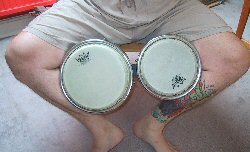
Playing position sitting
When tuning the drums, the small drum
should be cranked up as high as you dare whilst the larger drum should
be tuned somewhat lower than this (personal preference). I have come to prefer the Remo bongos with heads that
you can leave tuned up when you have finished playing and rely on even
in a very humid environment.
Basic strokes
VIDEO

The high-pitched sound is articulated by
striking with the tip of the finger for quieter playing or with the tips
of all the fingers for louder playing. The fingers should strike as near
the edge of the drum as possible and should create a very high pitched
tone. The small drum should be cranked up as high as you dare. Try this
simple single stroke pattern with both hands on the hi Bongo. R L R L R
L R L Try to make the strokes as even as possible and try a few
different speeds. (R = Right and L = Left)
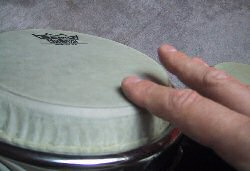
Open tone hi bongo, Right hand single finger
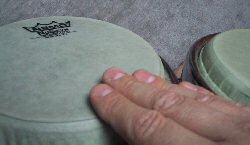
Open tone hi bongo, Right hand all fingers
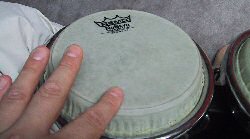
Open tone hi bongo, Left hand single finger
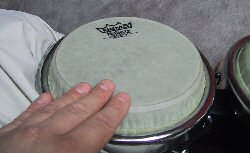
Open tone hi bongo, Left hand all fingers
Next we have the open tone on the larger
drum. This is articulated with the first finger played slightly more
towards the centre of the drum than on the small drum. This helps
accentuate the bass tone by bringing out some of the lower harmonics.
Experiment by hitting the bass drum near the edge as with the high drum
and see how different the sound is. Again, it is possible to use all
four fingers for louder situations, although I still prefer to stay with
the single finger on the larger Bongo.
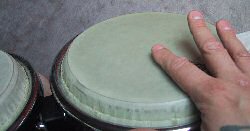
Open tone Lo bongo, Right hand one finger
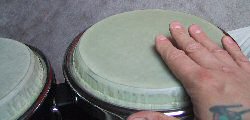
Open tone lo bongo, Right hand all fingers
Now we'll move on to some simple rhythmic
motifs and some grooves based on the simplified form of the Cuban
Martillo (mah-tea-oh). We will move on to some more
intricate Bongo techniques a little later. These four rhythms are a simple extension of the R L R
L pattern we were looking at earlier. Example one is articulated
by adding a few accents and one single strike on the low bongo on beat
four of the bar. Accents are articulated by striking harder than
the non accents which are played slightly softer. For all notation
the hi Bongo is written on the upper line and the lo Bongo on the lower
line.

Simple Martillo
Click to enlarge VIDEO
VIDEO


Simple Martillo Variation 1
Click to enlarge VIDEO
VIDEO


Simple Martillo Variation 2
Click to enlarge VIDEO
VIDEO


Simple Martillo Variation 3
Click to enlarge VIDEO
VIDEO

Now we’re going to look at the more
intricate method of the Martillo technique utilising the left-hand
finger tips and thumb to mute the sounds. The basis rhythm spans one bar
of eighth notes. We need two new strokes for this rhythm. These
are the left hand finger tip stroke and the left hand thumb stroke.
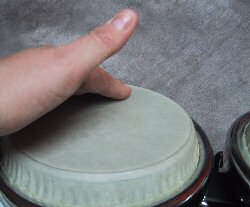
Left hand finger tip stroke
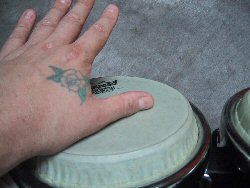
Left hand thumb stroke
By using these strokes, different pitches
can be created when the finger tip and
thumb strokes are left on the head whilst striking with the other
hand.
Muted strokes
To begin with, place the edge of the
thumb flat on the head of the small bongo as in fig (a). The whole of
the side of the thumb right up to its base should be in contact with the
head and should apply a gentle degree of pressure. Notice the exact
position of the hand on the head allowing room for the right hand to
strike the drum without the thumb getting in the way.
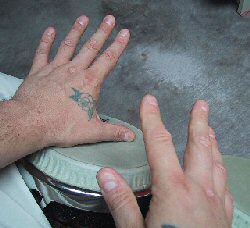
Fig A
With the thumb in this position strike the small drum at the edge with
the first finger of the right hand. Hit as near the edge as possible as
in fig b. The sound should be sharp and almost woodblock-like.
Experiment with the position of the thumb and vary the degree of
pressure to find the sharpest sound possible. This is the first
beat of the bar.
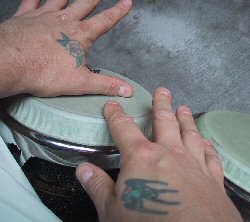
Fig B (Eighth note #1 of the bar)
The next stroke of the bar is played with
the fingertips. Pivot the hand up from the first thumb position to
create a cup-like hollow as the fingers strike the head. Only the tips
of the fingers should strike and then remain in contact with the head.
The sound should be muted with the fingers not bouncing off after
impact.
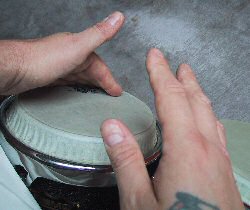
Fig C (Eighth note #2 of the bar)
The third stroke of the rhythm is with
the right hand. With the left hand remaining in this position with the
finger tips on the skin. This takes the high edge off the mute as the right hand strikes.
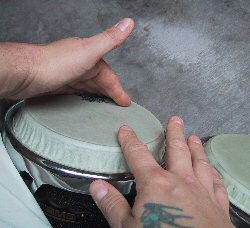
Fig D (Eighth note #3 of the bar)
The fourth stroke of the rhythm sees the left hand thumb returning to
the head with a sharp action. The thumb should remain in contact with
the head after striking and not bounce off. The sound should be slightly
sharper in tone than the left-hand fingertip stroke. The thumb should
remain in position to create the mute for the next right-hand stroke.

Fig E (Eighth note #4 of the bar)
The next 2 strokes of the rhythm are
identical to the first 2 strokes of the rhythm.

Fig F (Eighth note #5 of the bar)

Fig G (Eighth note #6 of the bar)
The seventh stroke of the rhythm involves
an open tone on the larger bongo with the right hand.

Fig H (Eighth note #7 of the bar)
The final stroke of the rhythm sees the
left-hand thumb returning to the head with a sharp action. The thumb
should remain in contact with the head after striking and should not
bounce off. The sound should be slightly sharper in tone than left-hand
fingertip stroke.

Fig I (Eighth note #8 of the bar)
| Basic Martillo variations |
Here is the basic Martillo rhythm, followed by two
variations.

Basic Martillo
Click to enlarge VIDEO
VIDEO


Basic Martillo Variation 1
Click to enlarge VIDEO
VIDEO


Basic Martillo Variation 2
Click to enlarge VIDEO
VIDEO

Here are some Martillo style rhythms loosely based on
the traditional technique. The variations use the techniques from
the simple Martillo we looked at earlier combined with the more
intricate fingerings of the traditional rhythm. You can get some
interesting variations by switching between these two styles within one
groove.

Martillo style Variation 1
Click to enlarge VIDEO
VIDEO


Martillo style Variation 2
Click to enlarge VIDEO
VIDEO


Martillo style Variation 3
Click to enlarge VIDEO
VIDEO

Now we can move on to the
slap stroke. The slap stroke is the sharp cutting sound we often
associate with Conga/Djembe playing. It is one of
those things that you can be shown and practice for months and still
have trouble executing, then one day it just
happens. Spend time working on the slap stroke. Notice how it is a sort of 'cup the
hand' and 'grab' type motion.
After you have struck the head you leave the finger tips on the head and
grab slightly, like you were pulling some string in towards yourself.
It is not a stroke that necessarily needs to be articulated violently,
even though it sounds accented and aggressive. It is a
knack and if you try for long enough you
will get it, believe me. It's not rocket
science!
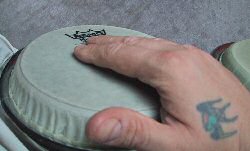
Right hand slap stroke
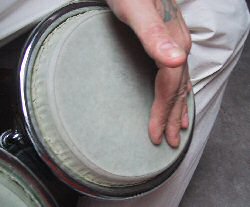
Left hand slap stroke slightly further into the drum
Now lets incorporate the slap stroke and it's combination
within some grooves.

Slap stroke groove Variation 1
Click to enlarge VIDEO
VIDEO


Slap stroke groove Variation 2
Click to enlarge VIDEO
VIDEO


Slap stroke groove Variation 3
Click to enlarge VIDEO
VIDEO

bongo 1.pdf
bongo 2.pdf
bongo 3.pdf
Conga Lessons, All you need to know!


|

